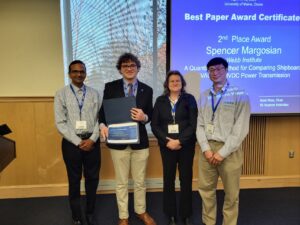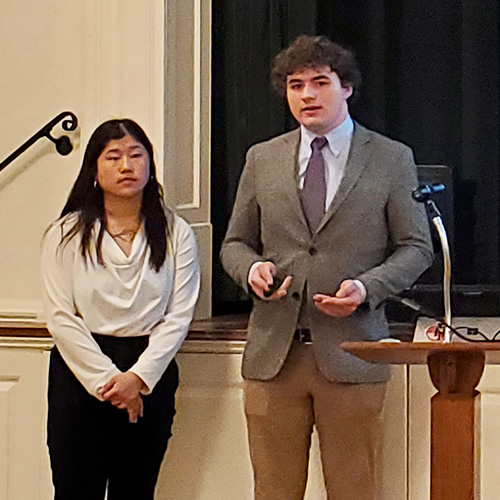
 By Spencer Margosian ’23 and Tori Kim ’23
By Spencer Margosian ’23 and Tori Kim ’23
It is the beauty of research that in pursuit of solving even a seemingly simple problem, one will inevitably discover far more new problems to solve than they will answers to publish. Looking back on the past year, the best example of this was when our electrical engineering thesis was almost completely derailed for well over a month, by a problem fundamental to naval architecture. In this article, we would like to discuss how we came across this problem, how we solved it, and how this detour in our work taught us a fundamental principle of research. The minimum viable background for discussion of our thesis takes about four sentences. For large vessels, medium-voltage alternating current is usually used to transmit electrical power.
An emerging technology, medium-voltage direct current power transmission, is poised to be ready for commercial application approximately within the next decade. Because MVDC is a new technology, it is not well known to marine engineers and will likely be underutilized if it remains unknown.

Spencer Margosian ’23 accepting his award during SNAME’s Student Paper night.
Our thesis sets out to identify in simple terms whether MVAC or MVDC is the better system model for a given application so that a marine engineer does not need to do so from first principles. The first time we attempted to compare the two
system models directly, we created two calculation methods which modeled steady-state operation of a given vessel. When we tested the two methods with a computer script, the answers they returned looked like they made sense when considered one-at-a-time. Upon examining the entire set of cases, however, we realized that not a single case actually implied that DC was preferable to AC—not even those which we were positive would be.
The discovery of this fault effectively stopped us in our tracks, not knowing what we had done wrong or how we might fix our program to account for such error. To solve this problem, we would have to embrace a core principle of research: that setting out to solve a problem in one field will often result in encountering new problems in unrelated ones. Following the failure of the original analysis, we would come to realize that using a steady-state analysis failed to account for the biggest advantage of MVDC systems, which is their high efficiency in loads which vary over time. This meant that to properly compare the two system models, it would be necessary to model them as dynamic systems and not constant signals.
“We are immensely grateful to Webb for preparing us not only with the education in marine engineering necessary to understand marine electrical engineering, but also for providing us the naval architecture background that we needed to solve our resistance problem. Despite neither of us identifying as naval architects at heart, the Webb education prepared us to tackle every problem our research threw at us.”
We had found a new problem to solve—how does a ship’s electrical load change throughout a voyage?—and despite our original research being one of theoretical electrical engineering, the answer to our new question relied almost exclusively on our understanding of naval architecture.
The biggest load experienced by a ship at sea is naturally the energy required to propel the vessel through the water. As a ship sails through waves, the resistance imparted on the vessel varies constantly, changing the propulsion power. This phenomenon, called added wave resistance, cannot be easily predicted using statistics—in fact, it is not analytically possible to do so. However, by algebraically manipulating a well-documented standardized wave spectrum, we were able to closely approximate what the added wave resistance spectrum would look like and solve our original problem of characterizing how resistance varies over a voyage.
Watch Spencer and Tori’s Thesis Presentation below:
Click here to view the Class of 2023 Thesis Page

